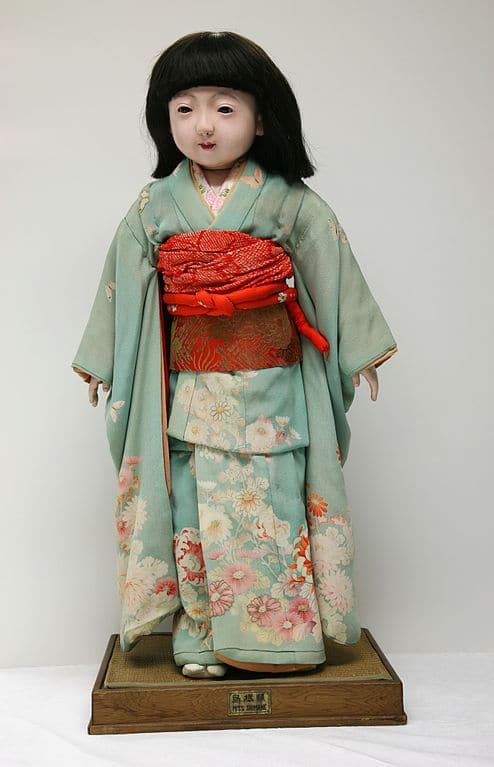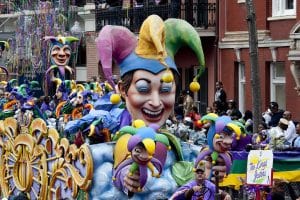March 3, 2019 - Hinamatsuri
Hinamatsuri (also known as Hina-matsuri or Hina Matsuri) is a Shinto and Japanese cultural holiday. Hinamatsuri means Doll Festival, but the day is also referred to as Girl's Day. This festival is celebrated every year on March 3. For this festival, families pray for the happiness and prosperity of their girls. Families with young girls celebrate by displaying hina-ningyo. Hina-ningyo are special dolls, made for this day. This tradition is traced back to the Edo Era (1603-1876) in Japan, when the dolls were used to ward off evil spirits. Now, people display them out of tradition, rather than as lucky objects. These dolls are often handed down through the generations. They are brought out of storage for a few days, and then placed back until the next year.
A set of hina-ningyo usually includes fifteen dolls, all wearing Imperial Court clothes from the Heian Period. The dolls are arranged on a five or seven tier stand with a red cloth. The Emperor and Empress dolls sit on the top tier. Below them are two ministers, three ladies-in-waiting, and five court musicians. Some people choose only to display the Emperor and Empress dolls, and don't display the rest of the court.
Hina-ningyo also played a role in U.S.–Japan relations. In 1926, Dr. Sidney Gulick established the Committee on World Friendship Among Children. He believed if children became friends with foreigners, they would be less discriminatory towards foreigners as adults. He began a mission of friendship which involved sending dolls from the United States to Japan. Many Americans participated, and 12,739 Friendship Dolls were sent to Japan. Each doll had its own passport, train and boat tickets, and handwritten letters from American children. The American dolls arrived in Japan in time for Hinamatsuri. Once there, the dolls were distributed to schools throughout Japan. Japanese children responded by sending Japanese dolls to the United States for Christmas.
Learn more about the holiday here:
March 5, 2019 - Fat Tuesday/Shrove Tuesday/ Mardi Gras
Many revelers will be celebrating Fat Tuesday on March 5, 2019. The date of Fat Tuesday is determined by the date of Easter. It is forty seven days before Easter. Easter is the first Sunday after the first full moon on or after March 21. Therefore, the earliest Easter can be is March 22. However, members of Orthodox/Eastern churches use a Julian calendar instead of the Gregorian calendar to determine the date of Easter. The earliest Easter can be for Orthodox churches is April 4 and the latest is May 8.
The name Fat Tuesday is believed to have come from the practice of eating richer, fatty foods prior to fasting during the Lenten season. You may be more familiar with the holiday's french translation Mardi Gras. The holiday is also referred to as Shrove Day, Pancake Day, and Pancake Tuesday. Pennsylvania Dutch country, and other areas with large German populations, refer to it as Fastnacht Day. Regardless of what one may prefer to call the holiday, the principle remains the same. It is the last day of feasting and overindulgence before Ash Wednesday, which was the beginning of a fasting period for Christians. In addition to fasting, Christians also give up something special that they enjoy. Fat Tuesday is typically their opportunity to enjoy that favorite food or drink that they may be giving up for the long Lenten season.
Bourbon Street in New Orleans, Louisiana, is widely recognized as the epicenter for Mardi Gras celebrations. The holiday has evolved from being celebrated on just the day of Mardi Gras. It is now customary for festivities to span a two-week period. Locals and tourists alike enjoy carnival celebrations such as parades and of course plenty of food and drink. The exchanging of Mardi Gras beads is another staple custom during these celebrations.
Learn more with the books below:
March 6, 2019 - Ash Wednesday
Ash Wednesday is a very important holy day in the liturgical calendar. It is the first day of Lent and the Lenten season lasts for forty-six days, or forty days plus six Sundays. It is spent fasting, praying, and reflecting. This is in preparation for Christ's Resurrection on Easter Sunday, through which one attains redemption. Traditionally, one would give up something during Lent in remembrance of the forty-day fast Jesus experienced in the Judaean Desert.
The customs of Ash Wednesday come from the Jewish tradition of penance and fasting. Priests apply ashes during Mass and all are invited to accept the ashes as a visible symbol of penance. Even non-Christians and the excommunicated are welcome to receive the ashes. The ashes are made from blessed palm branches, taken from the previous year's Palm Sunday Mass. One interpretation is that the ashes symbolize the dust from which God made us. As the priest applies the ashes to a person's forehead, he speaks the words, "Remember that you are dust, and to dust you shall return." The priest may also speak the words, "Repent and believe in the Gospel." In this case, the ashes symbolize grief for one's sins. In some cases, ashes may be delivered by a priest or a family member to those who are sick or shut-in.
Given that Ash Wednesday is a day of prayer and fasting, many who celebrate the holiday take the day off work and stay at home all day long. It is considered inappropriate to dine out, to shop, or to go about in public after receiving the ashes. Feasting is also inappropriate. However, small children, the elderly and sick are exempt from this observance. It is not required that a person wear the ashes for the rest of the day, and they may be washed off after Mass. However, many people keep the ashes as a reminder until the evening.
Learn more about Ash Wednesday with the books below:
Lenten Survival Guide for Kids
If there's a particular celebration you or someone you know participates in that we missed, let us know by leaving a comment on this post. Or, if you think we got something wrong, please also comment and let us know. We try to be as accurate as possible, but if there's a mistake, we want to correct it.






Add a comment to: The Origins and Practices of Holidays: Hinamatsuri, Fat Tuesday, and Ash Wednesday